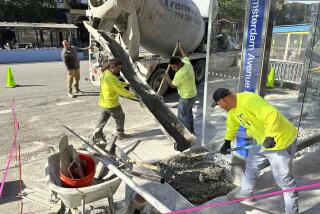Economic recovery marked by lower-paying jobs, analysis finds

The U.S. economy this year recovered all of the jobs lost during the recession, but the new jobs pay an average of 23% less than the ones lost in the downturn, according to a new analysis.
Job losses in the higher-paying manufacturing and construction sectors largely have been replaced by jobs in lower-wage industries, including hospitality and healthcare, according to a report released Monday by the United States Conference of Mayors.
“One of the really damaging things about this sluggish recovery is that wages have really not grown very much,” said Chad Stone, chief economist at the Center on Budget and Policy Priorities, a Washington think tank that focuses on policies affecting low- and moderate-income families. “Employers have more bargaining power everywhere, until the economy is stronger.”
At the same time, the nation’s high-income workers have continued to accumulate wealth at a significantly faster rate than middle- and lower-income households.
From 2005 to 2012, the top 20% of earners were responsible for more than 60% of all income gains in the country, the report said. By contrast, the bottom 40% saw only 6.6% of the increases. That continues the trend toward income inequality — one that the report’s authors contend will be a hallmark of the U.S. economy for years to come.
The outsized gains by the highest tier of workers is just the latest in a trend that has lasted more than a generation, said Gary Burtless, an economist and senior fellow at the Brookings Institution. More than any other time in the last 60 years, those who receive income through market investments or other assets such as real estate have a much greater income advantage, he said.
“If you own capital, you have fared better than people who depend on the sweat of their brow to earn their living,” Burtless said. “It’s really a phenomenon where top-end lawyers, financiers, sports stars, entertainment stars — the very top-end people in all these fields — have been putting bigger and bigger distances between themselves and those people who are merely well-off.”
Overall, metro areas with the most people earning more than $75,000 were concentrated in coastal California and the Northeast, according to the analysis. The largest concentrations of middle-income earners were in the Midwest and the Northwest. And the largest share of households making below $35,000 tended to be located in the South.
The Bay Area had some of the highest concentrations of upper-income earners in the nation, according to the report, prepared by IHS Global Insight for the Conference of Mayors. The study draws on the most recent U.S. Census data from 2012.
The San Francisco, San Jose and Ventura metro areas were among the top 10 metro areas with the largest shares of upper-income households (those earning more than $75,000 a year), out of more than 350 analyzed.
In the San Jose metro area, which includes Silicon Valley, more than 57% of households earn more than $75,000 a year; in the San Francisco-Oakland area, that number was nearly 50%.
“If you had to guess where you’re likely to see the most extreme disparity in incomes, Silicon Valley would be up there,” said Stone of the Center on Budget and Policy Priorities. “There are such huge rewards that really pull up the average.”
The San Jose metro area is also projected to see median income grow at the third-fastest rate in the nation through 2017. The Vallejo metro area, by contrast, is projected have one of the slowest rates of wage growth over the next three years.
The Los Angeles-Orange County metro area had a much more even distribution among income brackets. Nearly 39% of households earned more than $75,000, about 29% made between $35,000 and $75,000 and more than 31% earned less than $35,000.
The El Centro and Visalia metro areas in California had the highest percentage of households earning less than $35,000.
The income disparities between coastal California and inland areas reflect two separate ecosystems: one that has taken part in a global information and technology boom, and one that hasn’t, said Mark Schniepp, director of the California Economic Forecast.
“Whenever somebody asks me how California is doing, I always ask them, ‘Which one?’” Schniepp said. “The Bay Area is the tech capital of the world, and since that’s what’s in demand, that’s why it’s doing so well. It’s not in Calexico or San Joaquin.”







